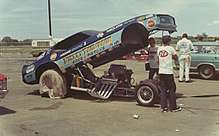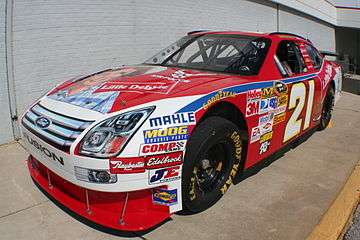Silhouette racing car
A silhouette racing car is a race car which, although bearing a superficial resemblance to a production model, differs mechanically in fundamental ways. The purpose of silhouette cars is to provide a manufacturer with a tangible link to their consumer product offering so as to derive maximum marketing benefit from their investment in the sport. They also provide spectators with familiar car models with which they can identify.
Entire championship fields can consist of silhouettes, or sometimes only a single class in a multi-class field may permit silhouettes. Notable racing classes where silhouette cars have been used include NASCAR, Group 5 Special Production Cars, Group B rallying, DTM, JGTC/Super GT, Monster truck and the Australian Supercars Championship.

Silhouette cars often employ radically different chassis construction techniques such as tubular space frames or carbon fibre tubs in place of regular monocoques, and many also have completely different drivetrain configurations than their road-going counterparts. The bodyshells themselves are generally made of lightweight materials such as glass-reinforced plastic or carbon fibre and often few or no parts are shared between race and road versions of the cars. These changes are aimed at improving the desirable characteristics of the components, such as increasing the stiffness of the chassis,[1] or the output of the engine.[2]
Due to homologation rules (e.g. Group B rally cars), some silhouette racing cars, such as the Lancia 037 and Lancia Delta S4, also end up being sold as road cars.
Gallery
 Mercedes C-Coupe AMG DTM, as seen at Hockenheimring Race II 2014
Mercedes C-Coupe AMG DTM, as seen at Hockenheimring Race II 2014_%E2%80%93_Frontansicht%2C_26._Februar_2012%2C_W%C3%BClfrath.jpg) Mercedes-Benz C 63 AMG Coupé (C 204), the road car the C-Coupe AMG DTM is based on
Mercedes-Benz C 63 AMG Coupé (C 204), the road car the C-Coupe AMG DTM is based on Lancia 037 rally car, based on the road-going Lancia Montecarlo
Lancia 037 rally car, based on the road-going Lancia Montecarlo Lancia Montecarlo road car; Note the similarity in centre section to the 037 at left
Lancia Montecarlo road car; Note the similarity in centre section to the 037 at left 2008 NASCAR Ford Fusion, clearly showing space frame construction and decals for headlights
2008 NASCAR Ford Fusion, clearly showing space frame construction and decals for headlights A road-going Ford Fusion for comparison
A road-going Ford Fusion for comparison
References
- ↑ GM Racing Technology Archived 2010-01-13 at the Wayback Machine.
- ↑ DTM technical specifications Archived 2008-10-11 at the Wayback Machine.